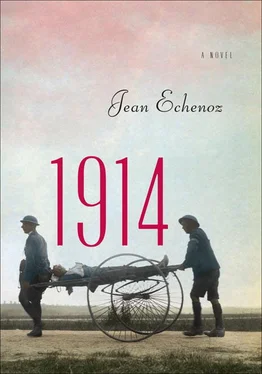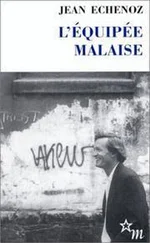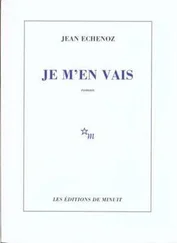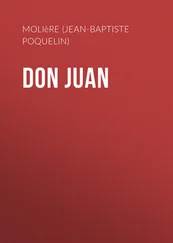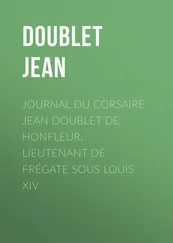Requests for permission to reproduce selections from this book should be mailed to: Permissions Department, The New Press, 120 Wall Street, 31st floor, New York, NY 10005.
Originally published in France as 14 by Les Éditions de Minuit, 7, rue Bernard-Palissy, 75006, Paris, 2012 Published in the United States by The New Press, New York, 2014
Distributed by Perseus Distribution
LIBRARY OF CONGRESS CATALOGING-IN-PUBLICATION DATA
Echenoz, Jean.
[14. English]
1914 : a novel / Jean Echenoz ; Translated from the French by Linda Coverdale.
pagescm
“Originally published in France as 14 by Les Editions de Minuit, 7, rue Bernard-Palissy, 75006, Paris, 2012.”
ISBN 978-1-59558-924-8 (e-book)
1. World War, 1914-1918 — France — Fiction. I. Title. II. Title: Nineteen fourteen.
PQ2665.C5A61413 2013
843’.914—dc23
2013013990
The New Press publishes books that promote and enrich public discussion and understanding of the issues vital to our democracy and to a more equitable world. These books are made possible by the enthusiasm of our readers; the support of a committed group of donors, large and small; the collaboration of our many partners in the independent media and the not-for-profit sector; booksellers, who often hand-sell New Press books; librarians; and above all by our authors.
www.thenewpress.com
Composition by dix!
This book was set in Stempel Garamond
24681097531
Euntes: Some parish priests practiced trades to supplement their incomes, and Raphaël Vanni, the curate at Bourgneuf in the département of Charente-Maritime, produced a line of bicycles named after Matthew 28:19, euntes ergo docete omnes gentes : go ye therefore, and teach all nations.
Aures Habet et non Audiet: Victor Hugo took the title of chapter 2 in book 4 of his last novel, Ninety-Three , from Psalms 115:6, aures habent et non audient: they have ears, but they hear not. The novel appeared in 1874, soon after the bloody uprising of the Paris Commune, and deals with the equally ferocious Royalist rebellions that began in the Vendée region in 1793, midway through the French Revolution, and spread through twelve of the freshly created western départements of France. When Anthime goes off to war on a troop train to the Ardennes in 1914 , he leaves from Nantes, which was the scene of major military engagements during the rebellion and such horrific Royalist reprisals against the populace that French universities today still debate the issue of un génocide vendéen . The excesses of the Terror are well known, but the appalling butchery of these revolts against the Revolutionary government still inspires revulsion and is the backdrop, perhaps most famously, of Balzac’s Les Chouans and Poulenc’s Dialogues des carmélites .
In his description of the alarm bells, Echenoz is making a clear allusion to a similar incident in Ninety-Three , the opening of the aforementioned chapter when the Marquis de Lantenac, a Royalist leader who has survived an attack at sea by Republican ships, is cast up on the coast of Brittany. There he experiences the same phenomenon: seeing the belfries of the villages spread out before him flashing white and black, white and black, he realizes that the wind is drowning out their sound. And recognizing the tocsin, he wonders for whom the alarm bells toll.
Iron rations: For a full illustrated description of these iron rations, including the origins of the terms “bully beef” and “monkey meat,” Google “Vivres de Réserve—France’s Iron Ration in World War 1,” and select the site of that name. The Standard Reserve Food ration included two tins of corned beef, twelve hardtack biscuits, two packets of dried soup, two coffee tablets, and two envelopes of ration sugar.
Albert Herter: The American painter Albert Herter lost a son in 1918, killed near Château-Thierry while fighting in the American Expeditionary Force commanded by General John “Black Jack” Pershing. In memory of his son, Herter gave Le Départ des poilus, août 1914 (The Departure of the Troops, August 1918) to France, where since 1926 it has hung in the Gare de l’Est. A fine image of this monumental painting may be seen by Googling “Le Départ des poilus, août 1914 | Clio-Photo” and selecting the site of the same name.
Christian Herter, the painter’s other son, became governor of Massachusetts and later served as secretary of state under Dwight D. Eisenhower.
bonnetière:The bigouden , the elaborate lace bonnet that was the traditional headdress of women in Normandy and Brittany during the seventeenth and eighteenth centuries, is still sometimes worn today on festive occasions. Because of their impressive height, these bonnets were kept in bonnetières , tall, narrow cupboards with a single door, and they can be well over a foot high. A famous Paris Match cartoon by the great Sempé shows a Breton woman sneaking a nip from a wine bottle hidden under the towering lace tube on her head.
manille: Manilla , a Spanish trick-taking card game, spread in the late nineteenth century to France, where it remained popular until 1940, and it is still widely enjoyed in the northern and southwestern parts of the country. Manille is played with a thirty-two-card piquet deck, usually by four players in two partnerships, but two or three players can manage it in a pinch.
Byrrh: Created in 1866, this French aperitif—a blend of red wine, alcohol, grape juice, and quinine—was particularly popular in France in the early twentieth century. Byrrh was sold in the United States until Prohibition and reintroduced to America in 2012.
Ace of Diamonds: L’as de carreau means “the ace of diamonds,” but carreau is also the word for “square,” so this nickname is a play on words. The other popular name for the knapsacks was Azor, the French equivalent of “Fido,” because they were originally made of dog skin.
Ardennes and the Somme: For hundreds of years the European powers have fought over the strategically valuable region of the Ardennes, although by the turn of the twentieth century the difficult terrain there was considered unsuitable for modern warfare. Nothing daunted, in both world wars Germany struck swiftly through the Ardennes to attack where France was poorly defended. The Battle of the Ardennes (August 21–23, 1914) was one of the opening battles of World War I, while in World War II, the Battle of France and the Battle of the Bulge devastated the region once again. In the Battle of the Ardennes, the French counted on their light, rapid-firing artillery to dominate the small German forces they anticipated encountering in wooded terrain favoring their firepower, but the unexpectedly significant German forces, strengthened by their advanced tactical positioning, turned the tables on the French, who retreated in disorder with heavy casualties and were kept essentially on the defensive until the Battle of the Marne.
The Battle of the Somme (July 1–November 18, 1916), one of the biggest and bloodiest battles of the war, was also one of the most deadly confrontations in history, with a butcher’s bill of more than a million casualties. The French and British armies, supported by troops from British imperial territories, mounted a joint offensive against the German army, which had by then taken considerable French territory at great cost to both sides and was pressing France hard in its siege of Verdun. Specifically developed to break the deadlock of trench warfare on the Western Front, tanks were first used in combat by the British in the Battle of the Somme, but by the time the Germans withdrew to their fortified Hindenburg Line, the French and British forces had managed to penetrate only a few miles into German-occupied territory.
Читать дальше
